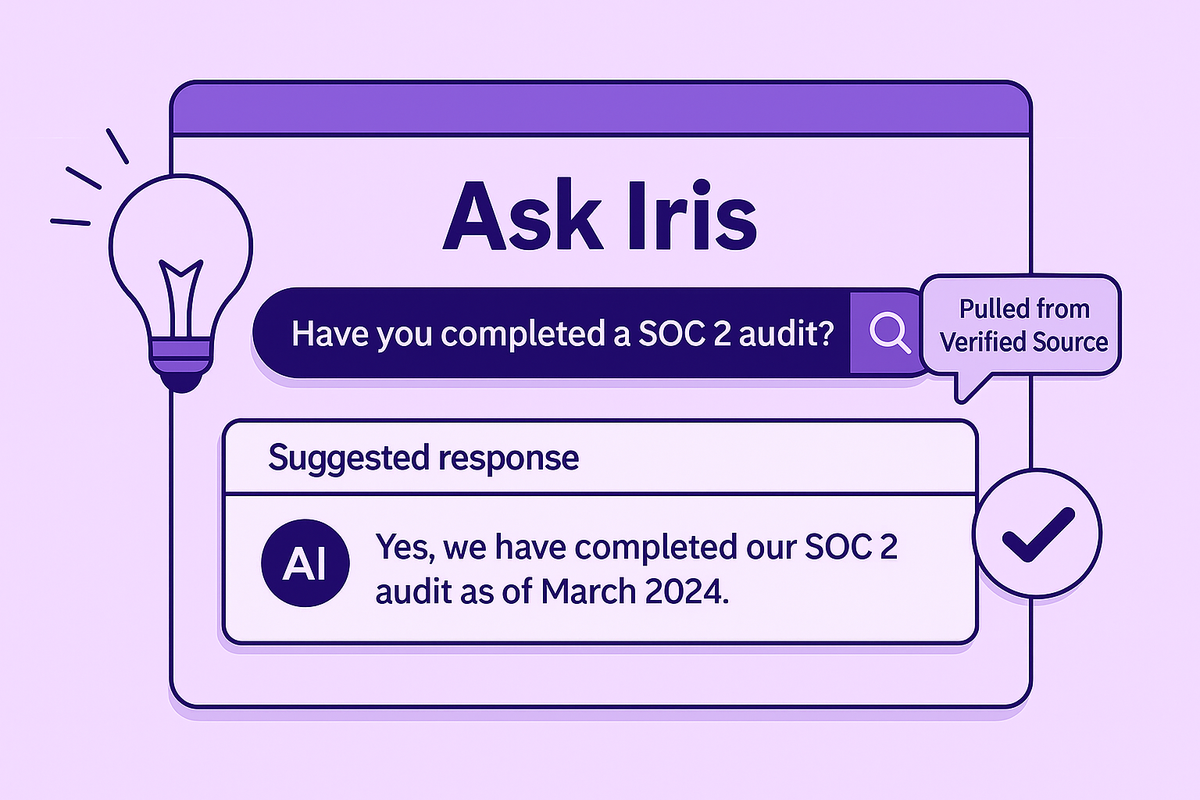What is an RFP in Sales? A Complete Guide
May 27, 2025
By
Evie Secilmis

The traditional RFP response process is broken. It’s a cycle of patchwork, pressure, and burnout. We’ve all been there: scrambling through old documents for answers, nagging colleagues to "finish their part," and submitting a proposal that feels generic and rushed. Buyers notice. When your response doesn't reflect the true value of your solution, the opportunity to differentiate is lost. This article is about leaving that fire drill behind. We’ll get back to basics on what an RFP is and explore how to build a proactive, collaborative process that turns these requests from a burden into your team’s secret weapon for winning more business.
How to Turn RFP Fire Drills into Forward Motion
For many sales teams, RFPs still feel like a fire drill. They’re something to survive—fast, chaotic, and reactive. But here’s the truth: when rushed and treated as a last-minute task, RFPs don’t just risk deals. They erode trust.
I’ve heard the line more times than I can count. I’ve said it myself:
“Just give them anything.”
I still remember the last time a sales rep came to me and said,
“Hey Ben, can you help me with this RFP—just one last time?”
I nodded—but I knew there wouldn’t be a last time. Because there never is.
The RFP Loop: Patchwork, Pressure, and Burnout
The cycle is always the same:
- Pulling content from six different teams
- Filling gaps while someone’s out on PTO
- Piecing together outdated answers
- Missing deadlines
- Losing momentum
Eventually, it doesn’t feel collaborative—it feels like being nagged to “finish your part.” It’s exhausting. And somehow, we keep doing it. Again and again.
When RFPs are treated this way, responses feel generic. Buyers notice. And the opportunity to actually differentiate is gone.
We Needed Jetsons-Level Solutions for Flintstones-Era Problems
That’s been my line for years, and it still holds up.
My grandfather used to complete RFPs for Lockheed Martin—on a typewriter. Decades later, we’re doing them with AI.
But here’s the catch: most RFP tools don’t feel like the future. They’re new tech duct-taped onto the same broken workflows. Flashy UI, same chaos behind the scenes.
Why Iris Is Different
We built Iris because we’ve lived through this mess. We know what it’s like to chase down subject matter experts at midnight. We’ve scrambled through Slack threads trying to get something—anything—over the line.
We didn’t want to just automate RFPs. We wanted to fix the process entirely.
Unlike generic AI tools or fragile custom builds, Iris delivers:
- Deterministic AI trained only on your internal, approved content
- Zero hallucinations, and no risky web-sourced data
- Real collaboration—tag teammates, assign reviews, and track progress
- Clear audit trails for every answer, so compliance isn’t a blocker
- Dynamic knowledge base that evolves with every response
Iris isn’t a new layer on top of an old problem—it’s a different foundation altogether.
Leave the Fire Drill Behind
RFPs don’t have to be a burden. When done right, they become a strategic advantage. At Iris, we’re helping teams move from chaos to clarity—and finally make RFPs work the way they’re supposed to.
👉 Ready to see how Iris can help your team win faster and work smarter? Schedule a demo
What is an RFP, Really?
Before we can fix the RFP process, it helps to get back to basics. So, what exactly is a Request for Proposal? At its core, an RFP is a formal document an organization creates when it needs to purchase a product or service. It’s essentially an open invitation for vendors to submit a business proposal outlining how they can meet the organization's specific needs. Think of it as a company raising its hand and saying, “We have a problem we need to solve or a goal we want to reach, and we’re looking for the best partner to help us get there.” This document lays out the project details, scope, and requirements, creating a level playing field for all potential suppliers to present their unique solutions and pricing.
The Basic Definition
A Request for Proposal (RFP) is a document that an organization sends out when it wants to buy a service or product. It asks different companies to send in their ideas and plans for how they can provide that service or product. Unlike a simple price request, an RFP is used when the solution is more complex and requires a detailed, customized approach. The buyer isn't just looking for the cheapest option; they're looking for the best overall value, which includes the vendor's expertise, strategy, and ability to deliver on their promises. It’s a structured way to compare different vendors on more than just cost, ensuring the final choice is a true strategic partner.
Why Companies Use Them
Organizations turn to RFPs for big, complex projects that have a lot of moving parts. When a purchase involves significant investment, technical specifications, or long-term service agreements, an RFP helps the buyer clearly define their project, goals, and expectations from the start. According to Investopedia, this process is crucial for projects that might require many different workers or components. By putting everything in writing, companies can ensure that all vendors are bidding on the same set of requirements. This structured approach minimizes misunderstandings and helps the buying organization make a well-informed decision based on a direct comparison of different proposals, rather than just a sales pitch.
Common Industries That Rely on RFPs
While they’re especially common in government, construction, and tech, RFPs are a vital tool for companies across nearly every industry. From marketing agencies bidding on a new campaign to software companies proposing a new enterprise system, the RFP process is a standard for procurement. It’s designed to ensure fair competition and helps the buyer confirm that the chosen solution truly meets their needs and goals. This formal process creates transparency by documenting the project requirements and evaluation criteria, which helps protect both the buyer and the vendor. It’s a foundational part of how businesses make major purchasing decisions in a fair and organized way.
The Buyer's Roadmap: A Look at the Formal RFP Process
For vendors, the RFP process can sometimes feel like a black box. You submit your proposal and wait. But on the buyer's side, there’s a structured journey taking place. Understanding this roadmap can help you tailor your response more effectively and anticipate the next steps. The process is designed to be methodical, ensuring the organization can carefully evaluate each proposal against its predefined criteria. It starts long before the RFP is ever released publicly and continues well after the submission deadline has passed. Knowing these internal steps gives you a strategic advantage, allowing you to align your proposal with the buyer's decision-making framework and timeline.
The Key Stages from Start to Finish
The formal RFP process typically follows a clear set of stages. First, the organization identifies a need and assembles a team to draft the RFP, outlining the project's scope, objectives, and requirements. Sometimes, they might release a draft version to gather feedback from potential vendors before finalizing it. Once the final RFP is released, vendors get to work on their proposals. After the submission deadline, the buyer's evaluation team reviews all the bids, often scoring them against a predetermined rubric. From there, they’ll narrow it down to a shortlist of top contenders, who may be invited for presentations or further negotiations before a final winner is selected and a contract is awarded.
Typical Timelines for a Response
While the overall timeline can vary wildly depending on the project's complexity, the review period itself is often shorter than you might think. Once all proposals are submitted, a typical review period for the buyer’s team is about two weeks, according to Adobe. During this time, the evaluation committee is busy reading, scoring, and debating the merits of each submission. This is why a clear, concise, and easy-to-read proposal is so important—it makes the reviewers' job easier. After this initial review, the process of creating a shortlist, holding presentations, and negotiating a contract can add several more weeks or even months to the timeline before a final decision is made.
The Other Side of the Table: Challenges for Vendors
While RFPs create a structured process for buyers, they present a unique set of challenges for the vendors responding to them. The pressure to deliver a high-quality, customized proposal within a tight deadline is immense. It’s not just about answering questions; it’s about telling a compelling story that showcases your company's value and expertise. This often requires a significant investment of time and resources from multiple departments, including sales, marketing, legal, and subject matter experts. For many teams, especially smaller ones, the effort required can be a major hurdle, turning a potential opportunity into a resource-draining fire drill that pulls people away from their core responsibilities.
The Time and Cost of a Quality Proposal
Let's be honest: writing a winning proposal is complicated and takes a lot of time. It’s a high-stakes project that can easily consume dozens or even hundreds of hours of work from your most valuable team members. This significant investment of time and effort can make it difficult for smaller companies to compete, potentially limiting the buyer's choices. This is where the process often breaks down, and why tools that streamline proposal creation are becoming essential. By using an AI deal desk solution, teams can automate the tedious parts of the process, like finding approved answers and formatting documents, allowing them to focus on strategy and customization instead of administrative busywork.
Best Practices for Crafting a Strong RFP
If you're on the buying side, creating a clear and effective RFP is the single most important thing you can do to attract high-quality proposals. A well-crafted RFP sets the stage for a successful partnership by giving vendors the exact information they need to deliver a thoughtful and relevant solution. It’s not just about listing your requirements; it’s about providing context, defining success, and being transparent about your evaluation process. A great RFP saves everyone time and frustration by minimizing back-and-forth questions and ensuring the proposals you receive are easy to compare. It’s an investment that pays off by attracting the best-fit partners for your project.
Assembling the Right Review Team
Before you even start writing, decide who will be responsible for reading and judging the vendor proposals. A strong evaluation team is a cross-functional one. It should include the project sponsor, key department leaders, and representatives from purchasing, IT, legal, or finance, depending on the project's nature. According to Adobe, getting these stakeholders involved early ensures that all critical perspectives are considered when evaluating proposals. This collaborative approach not only leads to a better decision but also builds internal buy-in for the chosen vendor from the very beginning, which is crucial for a smooth implementation down the road.
Finding the Balance Between Vague and Overly Detailed
Crafting the perfect RFP is a balancing act. If your document is too vague, you’ll receive generic proposals that are difficult to compare because vendors are left guessing what you truly need. On the other hand, if it's too detailed and prescriptive, you might stifle the creativity and innovation that you’re hoping to find in a new partner. The goal is to provide enough detail for vendors to understand your core challenges and objectives, while leaving them enough room to propose their unique solutions. Focus on defining the "what" (your goals) and let the vendors impress you with the "how" (their approach).
The Importance of Transparency and Confidentiality
A well-structured RFP makes the selection process clear and honest for everyone involved. By putting all project needs and evaluation criteria in writing, you create a transparent framework that builds trust with potential vendors. This ensures that all suppliers are judged on the same metrics, promoting fairness and accountability. At the same time, it's important to handle the proposals you receive with confidentiality. Vendors are sharing sensitive information about their pricing, strategy, and capabilities. Respecting that confidentiality is key to maintaining a professional reputation and encouraging the best companies to participate in your future procurement processes.
Decoding the Alphabet Soup: RFP vs. RFI, RFQ, and More
If you’ve been in the sales world for a while, you know the procurement process is filled with acronyms. RFP, RFI, RFQ—it can feel like you need a decoder ring just to figure out what a potential customer is asking for. While they all fall under the umbrella of "RFX" documents, each one serves a very different purpose and requires a distinct type of response. Understanding the nuances between them is key to allocating your resources effectively and making sure you’re providing the right information at the right stage of the buyer's journey. Let's break down the most common terms so you can respond with confidence.
RFP vs. RFI: Gathering Information
The main difference between an RFP and an RFI comes down to intent. An RFI, or Request for Information, is used much earlier in the buying process. A company sends out an RFI when it’s trying to gather general information to better understand the market landscape. They’re not ready to buy yet; they’re in an educational phase, exploring what solutions are available from different suppliers. An RFP, on the other hand, is sent when the organization has a specific project in mind and is actively seeking proposals to solve a defined problem. Think of it this way: an RFI is for research, while an RFP is for selection.
RFP vs. RFQ: Seeking a Price
An RFQ, or Request for Quote, is the most straightforward of the three. A company uses an RFQ when it knows exactly what product or service it needs and is primarily focused on getting pricing from different suppliers. For example, if a company needs to buy 100 new laptops with specific technical specs, it will send out an RFQ to get the best price. Unlike an RFP, where the solution itself is part of the proposal, an RFQ assumes the "what" is already decided. The main variable is cost. So, if the request is highly detailed with specific line items and quantities, you’re likely dealing with an RFQ.
Other "RFX" Documents to Know
Beyond the big three, there are a few other "RFX" documents you might encounter. While less common, knowing what they are can help you understand the buyer's specific needs and procurement style, especially when dealing with government agencies or highly specialized projects.
Request for Tender (RFT)
Often used by governments and public sector organizations, a Request for Tender (RFT) or Invitation to Tender (ITT) is typically more rigid than an RFP. It usually involves very specific requirements and a structured evaluation process where price is often a heavily weighted factor.
Request for Qualifications (RFQ) / Pre-Qualification Questionnaire (PQQ)
Don't confuse this RFQ with a Request for Quote! A Request for Qualifications (sometimes called a PQQ) is a preliminary step that happens *before* an RFP is issued. It’s used to vet and pre-qualify vendors, creating a shortlist of companies that will be invited to respond to the actual RFP.
Request for Solution (RFS)
A Request for Solution (RFS) is similar to an RFP but is even more open-ended. It’s used when a company has a business problem but has no preconceived notion of what the solution should be. An RFS gives suppliers maximum freedom to be creative and propose their best, most innovative ideas.
Frequently Asked Questions
What's the first, most practical step my team can take to move away from the RFP fire drill? The best place to start is by building a single source of truth for your content. It doesn't have to be perfect overnight. Begin by gathering your top 20 most frequently used answers and getting them approved by your subject matter experts. Creating this central, trusted library is the foundational step to shifting from a reactive scramble to a proactive, strategic process. It ensures you're not reinventing the wheel or hunting through old documents every single time a new request comes in.
How can a small team realistically compete with larger companies that have more resources for RFPs? Smaller teams can win by being smarter and more focused, not by trying to outwork larger competitors. Your advantage is agility. Instead of drowning in administrative tasks, use a streamlined process to free up your experts to focus on what matters: tailoring a compelling story that speaks directly to the buyer's needs. A well-crafted, strategic proposal that showcases deep understanding will always stand out more than a generic one, regardless of the team size behind it.
We get RFPs that are really vague. How should we handle those? A vague RFP can be frustrating, but it's also an opportunity to guide the conversation. If the process allows for it, ask clarifying questions to show your engagement and expertise. If not, shift your proposal's focus from just answering the questions to defining the problem and presenting your unique solution. Demonstrate that you understand their underlying business challenges, even if they haven't spelled them out. This positions you as a strategic partner, not just a vendor checking boxes.
Is using AI for RFPs just going to create more work for my team? That’s a valid concern, especially since many new tools just add another layer of complexity to a broken process. The right AI tool, however, should do the opposite. Look for a solution that works with your team's existing knowledge and is trained only on your own approved content. The goal isn't to add another complicated system to manage; it's to eliminate the tedious, manual work of finding information so your team can spend their time on strategy and customization.
How do we decide which RFPs are actually worth our time and effort? Chasing every RFP is a fast track to burnout. The key is to develop a simple "go/no-go" process. Before you start writing, ask a few critical questions: Does this project align with our core strengths? Do we have a relationship with the buyer or a champion inside the organization? Does the timeline and budget seem realistic? Being disciplined about which opportunities you pursue ensures you invest your team's valuable time on the deals you have a genuine chance of winning.
Key Takeaways
- Move beyond reactive RFP responses: The chaotic, last-minute scramble to piece together proposals leads to team burnout and generic submissions. A proactive, organized process is your best tool for creating responses that stand out and actually win.
- Understand the buyer's roadmap: Winning proposals aren't just about answering questions; they're about aligning with the buyer's internal process. Knowing their evaluation stages helps you tailor your response to position your company as a strategic partner, not just another bidder.
- Adopt technology that fixes the workflow: Don't just layer new tools onto a broken process. A true AI deal desk solution creates a reliable knowledge base from your own approved content and streamlines collaboration, transforming RFPs from a resource drain into a strategic advantage.
Related Articles
- Key Strategies to Optimize RFP Efficiency
- Best Practices for Writing an RFP
- Top Strategies to Optimize RFP Efficiency
- Steps to optimize your RFP process for faster bids
- RFP Guide: How to Write, Respond, & Win
Share this post
Link copied!




















